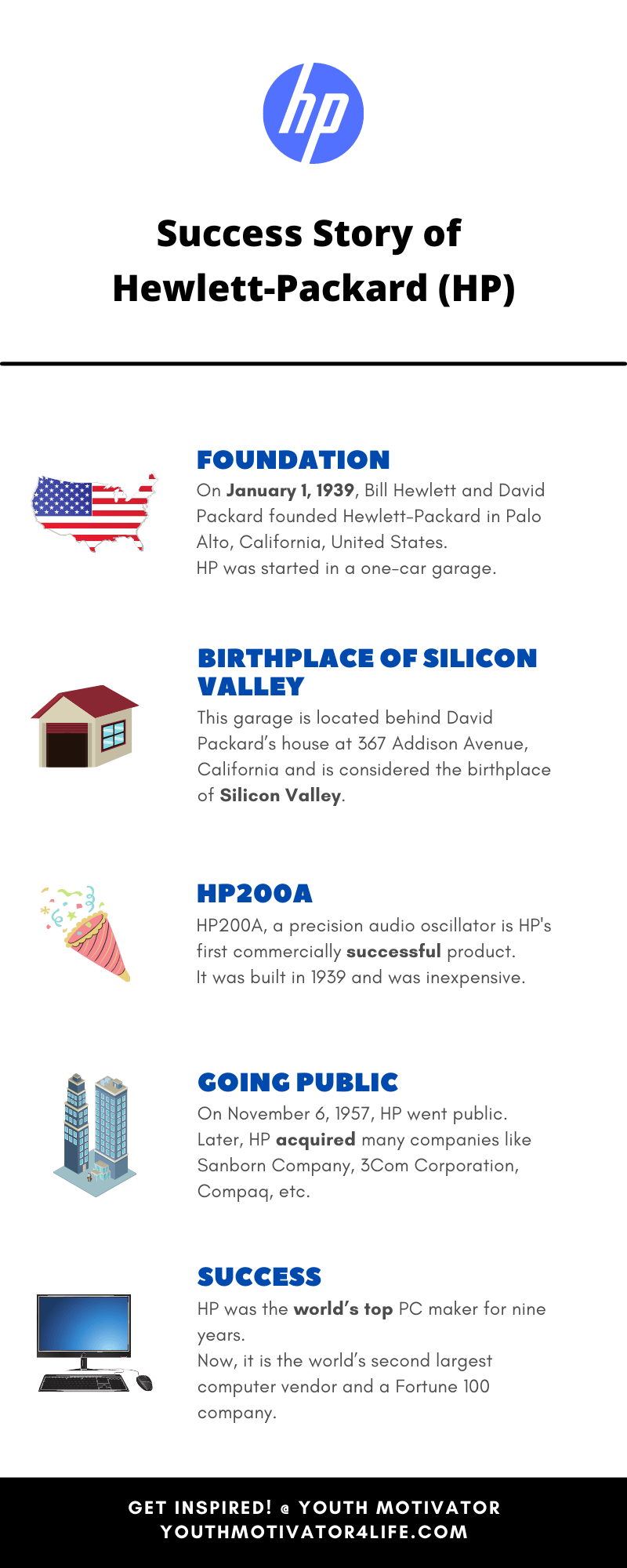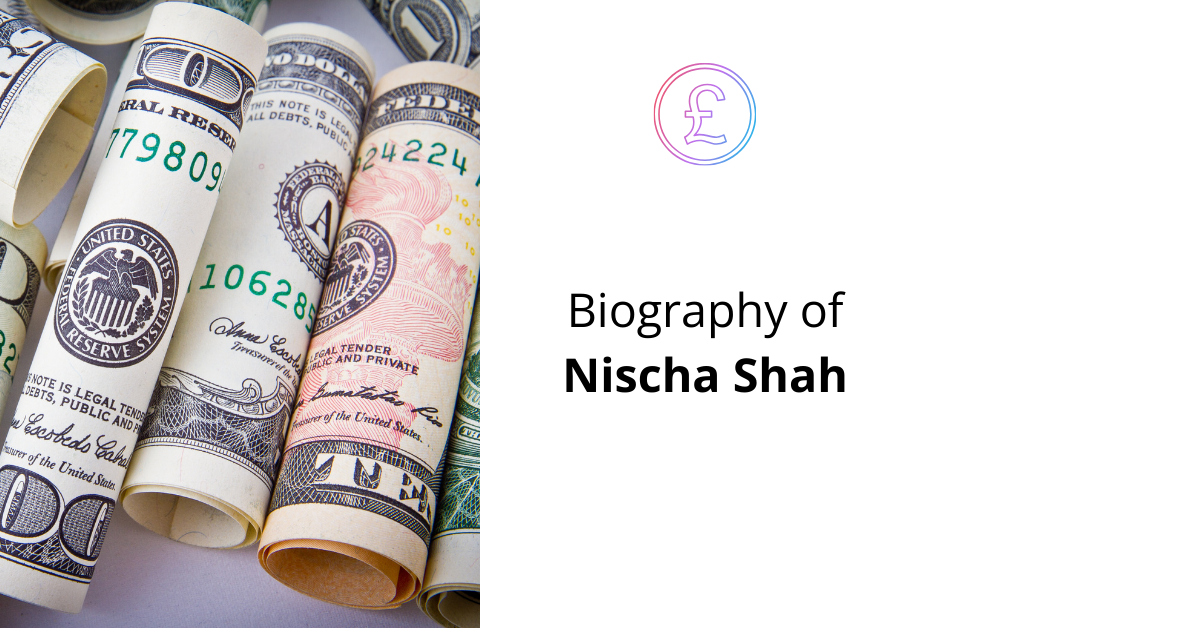Hewlett-Packard is a world renowned American multinational IT company and is headquartered in Palo Alto, California, United States.
HP made several significant inventions in the field of computers and now, it is the world’s second largest computer vendor only after Lenovo.
Introduction- About the founders-
Bill Hewlett-
William Redington Hewlett (Bill Hewlett) was born on May 20, 1913 in Ann Arbor, Michigan, U.S.
His father, Albion Walter Hewlett worked as a faculty at the University of Michigan Medical School.
In 1916, he was offered a faculty position at the Stanford Medical School and this made the family to shift to San Francisco.
Bill Hewlett attended the Lowell High School in San Francisco, California.
Unfortunately, in his school days, he suffered from severe dyslexia and as a result, he had a very unsuccessful academic career.
Dyslexia is a learning disorder which causes reading problems.
As the dyslexia severely impacted his writing skills, Bill Hewlett struggled with the written assignments.
But the silver lining was that dyslexia couldn’t affect his determination and with practice, he developed exceptional memorization and logical skills which enabled him to excel in mathematics and science.
Thankfully, Bill Hewlett’s competency gained him an entry into the Stanford University in 1930.
David Packard-
David Packard was born on September 7, 1912 in Pueblo, Colorado, U.S.
He attended the Centennial High School in Pueblo and from a very young age, he developed a passion towards science, electronics, engineering and leadership.
David Packard had a dynamic personality and was very outspoken.
He stunned his parents and teachers alike by building his first radio in the elementary school and later, he also joined the radio club at the high school.
In 1930, David Packard joined the Stanford University to study electrical engineering.
Becoming friends-
In the freshman year, he met Bill Hewlett for the first time in a radio engineering class.
They became friends during a camping trip and their friendship was cemented by their common passion for electronics.
In 1935, David Packard and Bill Hewlett graduated in electrical engineering from Stanford University.
They both were the students of Frederick Terman, widely regarded as the father of Silicon Valley.
In 1937, Frederick Terman became the head of the Electrical Engineering Department and played a vital role in building the outstanding engineering department at Stanford.
He taught David Packard and Bill Hewlett radio engineering at Stanford University and in 1941, Frederick Terman was president of the Institute of Radio Engineers.
He nourished their interest in electronics and inspired them to start their own companies.
Luckily, David Packard and Bill Hewlett agreed with Frederick Terman as they shared a common passion for innovation and entrepreneurship.
Hewlett-Packard or Packard-Hewlett-
The name of David Packard and Bill Hewlett’s startup was decided by tossing a coin.
They made a deal that whoever wins the toss, his surname would be added first to the company’s name.
As Bill Hewlett won the toss, the company was christened Hewlett-Packard.
Initially, they needed a house and garage to start their company.
The birth of HP-
On January 1, 1939, Bill Hewlett and David Packard founded Hewlett-Packard in Palo Alto, California, United States with an initial investment of US $538.
Eventually, their small startup gave birth to America’s Silicon Valley and HP became one of the world’s largest technology companies.
The company was started out of friendship in a one-car garage behind David Packard’s house at 367 Addison Avenue, California.
During that time, David Packard and his spouse, Lucile Salter lived in the bottom half of the house at 367 Addison Avenue and while Bill had a little shack at the back of the house.
The company was setup by David bringing drill press and other tools in the back of a car.
Initially, they baked the panels in Lucile Salter’s oven.
Later, David Packard and Bill Hewlett purchased an old refrigerator unit with good insulation to use it as an oven.
But unfortunately, the refrigerator overheated and caught fire.
Luckily, the fire department arrived and put out the flames, otherwise they might have lost their work and equipment.
Now, David Packard and Bill Hewlett’s garage is a private museum and a California Historical Landmark and is listed on the National Register of Historic Places.
The birthplace of Silicon Valley-
Their one car backyard garage is considered the birthplace of Silicon Valley.
Silicon Valley is the face of the technology and social media and many technology giants like Google, Facebook, Netflix, Apple, etc. are based there.
After founding the company, David Packard and Bill Hewlett began inspecting for the opportunities to integrate engineering, science and business through their company.
They began toiling hard everyday for many hours on many projects.
In their initial days, David Packard and Bill Hewlett had many ideas and made many products just to make money like a bowling alley foul-line indicator, an electric urinal flusher, a shock machine to help people lose weight, a device to tune harmonicas, an automatic lattice picker for the fields, etc.
The first successful product-
In 1939, after much trial and error, they were able to build their first commercially successful product, a precision audio oscillator which they named as HP200A.
The Model HP200A audio oscillator was an inexpensive instrument capable of producing high quality audio frequencies.
An audio oscillator is an electronic device used to generate a periodic, oscillating electronic signal and are employed in a wide range of industries ranging from defence to medicine.
Later, David Packard and Bill Hewlett sent out letters with a sales pitch describing their audio oscillators and their specifications to the universities and other institutions and in the process, they were able to receive three or four orders and they again repeated this marketing method.
At that time, even though they lacked the perfect tools, they had the much needed desire, energy and creativity.
The audio oscillators made by other companies were not only complex and expensive at around $200 but were also unstable.
But HP introduced a novel audio oscillator which employed a small incandescent light bulb to stabilize the amplitude of the outputs and this instrument was priced at just $89.40.
The first big order-
Walt Disney recognised the benefits of their audio oscillators and so, Bud Hawkins, chief sound engineer for Walt Disney Studios ordered eight 200B audio oscillators (an improved version of Model HP200A) for use in the 1940 animated film, Fantasia.
For this purchase, HP received a total payment of $572 from Walt Disney.
This was the first big order of HP and this really set the momentum of the company.
David Packard and Bill Hewlett’s invention of the HP200A audio oscillator in a small garage with few resources, inspired the whole Silicon Valley.
HP was profitable from its very first year of existence.
For most of the time, Bill Hewlett took care of the technical issues of the company while David Packard was interested in the financial areas of the company.
How World War II affected HP?
In 1939, the World War II broke out and America entered the war on December 7, 1941.
HP supplied the American military with the HP200A Oscillators and they were extensively used for several purposes like signal testing military equipment, etc.
HP also supplied other equipment like a wave analyzer, distortion analyzers, vacuum-tube voltmeters, etc.
Eventually, the sales of the company skyrocketed and by 1943, the sales neared $1 million.
This success motivated HP to invent and innovate with renewed spirits.
And by the end of the World War II in September 1945, HP had grown into a significant company by employing hundreds of people and it also gained popularity in the US.
Shifting from garage-
As the production of HP was growing, the David Packard’s garage was unable to accommodate its three employees and a product line of eight items.
So, in 1940, HP was shifted to a rented building in Palo Alto.
In 1942, the construction of the company building was started at 395 Page Mill Road, Palo Alto.
On August 18, 1947, HP was incorporated and in the same year, David Packard became the President while Bill Hewlett became the Vice President of the company.
The first acquisition-
In 1958, HP acquired F.L. Moseley Company and later HP’s Moseley division was formed for producing plotters and other graphic recording instruments.
Later, HP acquired many software companies like ABB CADE (December 1991), EEsof Inc. (October 1993), Optimazation systems (November 1997), Open Skies, Inc. (October 1998), Telegra Corp (May 1999), Bluestone Software (January 18, 2001), Trinagy Inc. (August 28, 2001), Persist Technology, Consera Software, TruLogica, Novadigm Inc., etc.
Going global and some important milestones-
On November 6, 1957, HP went public.
In 1959, HP opened a marketing organization in Geneva, Switzerland and also established a manufacturing plant in Böblingen, Germany.
In the 1960s, HP collaborated with Japan’s Sony and the Yokogawa Electric to produce high quality products.
Unfortunately, the products weren’t very successful owing to their expensiveness.
In 1961, HP acquired Sanborn Company, an American medical equipment company and this helped HP to enter into the American medical field and provide high quality medical equipment.
But in 1999, this division was sold to Philips Medical Systems.
In 1963, HP once again formed a joint venture with Yokogawa, named Yokogawa-Hewlett-Packard to sell HP products in Japan.
In 1964, HP developed the HP 5060A atomic clocks (also known as flying clock), these were accurate to within one-millionth of a second and set the new standard for international time.
But unlike other atomic clocks, HP 5060A was a rack-mountable and was neither bulky nor expensive.
In 1969, David Packard left HP to become U.S. Deputy Secretary of Defense and in 1971, he once again returned to HP to become Chairman of the Board.
In 1989, HP acquired Apollo Computer and six years later, in 1995 it acquired Convex Computer.
Making scientific calculators and computers-
In 1996, HP entered the computer world by making the HP 2100 / HP 1000 series of minicomputers.
In 1968, HP produced the world’s first personal computer, the Hewlett-Packard 9100A.
But interestingly, Bill Hewlett termed 9100A as a desktop calculator instead of a computer because he felt that 9100A did not appear like the IBM computers.
This machine was priced around $5,000 and had a CRT display (cathode-ray tube) and magnetic-card storage.
As in those days, the calculations were made with slide rules (slipstick) and adding machines, many people were dazed by this calculator.
The risk which paid well-
After building a desktop electronic calculator, Bill Hewlett was confident that it would be possible to make a handheld calculator which could fit in one’s palm or pocket.
But a market research report at that time recommended that HP should not make such calculator.
The report predicted that a pocket calculator would never succeed because at that time, the state of the art was a slide rule and the calculator would not only be very complicated but also very expensive than the slide rule at around $350.
So, according to the report, creating this calculator is needless because there will be no market for this.
But Bill Hewlett was very determined about his idea and wanted to take risk and realise his dream at any cost.
Challenging the engineers-
In 1971, he challenged the engineers at HP laboratories to make a miniature scientific calculator which could fit into his shirt pocket.
At that time, this was an unimaginable idea.
But Bill Hewlett strongly enforced this idea and succeeded in convincing the engineers that this could be done.
This limitless thinking astonished the world and in 1972, HP-35, the world’s first handheld scientific electronic calculator was made.
HP-35 was named after its 35 number of hardware keys.
Within no time the HP-35 calculators became very popular and sold like hot cakes.
During that time, HP couldn’t meet the high demand of these calculators.
Shifting from slide rule to calculator caused a big jump in functionality.
In 1974, HP made the HP-65, a handheld programmable calculator and in 1979, the HP-41C, a handheld programmable calculator with expandable memory.
The Hewlett Foundation-
In 1966, Bill Hewlett and his wife, Flora Lamson Hewlett founded the William and Flora Hewlett Foundation (Hewlett Foundation).
This foundation is located in Menlo Park, California and grants funds for the betterment of education, climate, health, etc.
A new CEO-
In 1978, John A. Young succeeded Bill Hewlett as the CEO and the present CEO of HP Inc. is Enrique Lores while Antonio Neri is the CEO for Hewlett Packard Enterprise.
Becoming the leaders in printers-
In 1984, HP released the inkjet and laser printers and HP is credited with creating the world’s first desktop laser printer, LaserJet.
Now, HP dominates the worldwide printing market.
Embracing the internet early-on-
HP is the ninth company in the world to register a .com domain.
On March 3, 1986, the domain HP.com was registered and on May 1999, HP incorporated hpshopping.com, an online consumer store.
As the company’s computer division was growing rapidly, in 1999, HP spun off to form Agilent Technologies.
After this, HP retained the computers and computer related business while the Agilent Technologies maintained the analytical and clinical research work in the scientific and laboratory settings.
Merging with Compaq-
In May 2002, HP united with Compaq, a computer company to form HPQ (Hewlett-Packard and Compaq).
This was the biggest acquisition of HP at a whopping US$25 billion.
But unfortunately, this coalition fell short in January 2005 due to poor performance.
Overtaking IBM and Great Recession-
The year 2007 was a very significant year for HP, as in this year, its annual revenue grew over $100 billions ($104 Billion) and HP overtook IBM.
On August 26, 2008, HP acquired Electronic Data Systems (EDS), an information technology equipment and services company for $13.9 billion.
In order to overcome the effects of the Great Recession (2007-2009), HP decided to enter into new profitable business areas, so on April 12, 2010, it acquired 3Com Corporation for approximately $2.7 billion.
This acquisition enabled HP to enter into the area of computer network products.
Splitting into two-
On November 1, 2015, HP split into two new publicly traded Fortune 50 companies, resulting in HP Inc. and Hewlett Packard Enterprise.
The HP Inc. held the HP’s PC and printing business while the Hewlett Packard Enterprise was meant to run the enterprise, server, storage, software and services businesses.
Ruling the PC market-
HP was the world’s top PC maker (by market share) for nine years (in 2001, 2002 and 2017 and in between 2007 to 2012).
The computers and printers of HP are very popular all over the globe.
Now, HP is a Fortune 100 company and present in more than 170 countries and employs more than 50,000 employees globally.
The advantage of adaptability-
HP is one of the few successful companies which has withstood the test of time and is still in perfect operational state for 81 years.
Adaptability, the capability to adapt to the changing times is the main reason for the longevity of the company.
HP always adapted with the times, initially it was a voltmeter company, then a microwave company (around 1940s and 1950s), then a calculator company (around the 1960s) and now, it is a computer and technology company.
Over the years, HP morphed its businesses by acquiring several companies.
In the present competitive world, innovation is the life blood of any successful business.
The companies which cannot update themselves with the times will get lost in history, luckily HP is not one of them.
The two valuable ‘I’s-
The founders, David Packard and Bill Hewlett felt the inventions and innovations should not take a back seat due to the daily business activities and so, on March 3, 1966, they established HP Labs.
The employees at HP labs were not assigned routine business activities but they were set free to innovate and invent new things.
The real purpose-
Once in 1948, David Packard attended a meeting of business leaders and CEOs of different companies.
In that meeting, a discussion was going on that the most important purpose of a company is to make the maximum profits to the shareholders.
But in the middle of the meeting, David Packard stood up and respectfully disagreed with the others by saying that a company should also be responsible towards the employees, customers and the community in which it operates.
He opined that the main purpose of his company is not to make money but it makes money as money is required to make contributions to the world.
Also, making profits are necessary to contribute to the fields of science and technology, care for the employees and for philanthropic activities.
David Packard did not change his stand even when the other CEOs chuckled at his words.
A boon for the employees-
During those times, many companies were very rigid and strict towards their employees.
This lack of autonomy choked the employees and they were unable to trust their employers.
Fortunately, David Packard and Bill Hewlett realised that this system does more harm than good by killing the creativity of the employees and so, they started working to create an ideal work culture where the workers can readily state their opinions without the fear of the management.
And this gave birth to the HP way.
The HP way-
David Packard and Bill Hewlett designed a new corporate culture and management style by name, the HP way.
This resulted in new standards and now, this culture is embraced by many businesses all over the world.
The key points of the HP way is to respect the individuals (employees), produce quality and reliable products at affordable prices and contribute to the community and humanity.
All these points created a strong sense of values and greatly influenced the culture at HP.
David Packard and Bill Hewlett believed that their business had a much greater purpose of serving the employees, customers and community rather than just making profits.
David Packard firmly believed that the employees should have some role in making the decisions in which they are going to be involved with because only by doing so, the workers will be more productive in executing those decisions.
The HP way fostered teamwork and innovation and enabled the employees to achieve and contribute more to the company and the community.
Manage by walking around and other good things-
One of the notable aspects of the HP way was the management by walking around.
In this method, the boss or the management will set the objectives and then, the employees were completely trusted and were given the full autonomy to complete the assigned tasks.
And the boss would simply walk around the office to clarify the doubts of the employees.
During that time, this was a very novel style of management.
Free flow of ideas-
Another important aspect was to ease the flow of ideas at all levels of the hierarchy.
To accomplish this, HP introduced an open door philosophy and many other things like addressing everyone by their first names and also regularly organised parties for its employees for helping the employees to socialize with each other and the management.
The employees were able to freely communicate with their bosses and CEOs.
This helped in the unrestricted flow of ideas which eventually enabled HP to rapidly expand into one of the biggest companies of the world.
They also introduced worker bonuses based on performance, health insurance and in the difficult times Fridays off without pay to avoid lay-offs.
More of a family than a company-
HP used to regularly organise annual picnics for its employees and David Packard and Bill Hewlett would also be present in the picnics.
Even after HP became a big company with thousands of employees, David Packard maintained very close personal relationships with his employees.
Both the founders were always connected to their employees.
Thanks to the informal atmosphere at HP, the employees were much more efficient than that of the other companies with a strict hierarchy.
All these measures turned HP into more of a family than a company.
David Packard and Bill Hewlett also inspired the employees to try new things and take risks.
Around 1967, HP became one of the first American companies to introduce the flexible work hours.
This allowed the employees to come to work at anytime between six to nine and work for eight hours.
HP also shared its profits with its employees.
David Packard and Bill Hewlett gave their employees all the opportunities and recognition to motivate them to make significant contributions to the company.
Expanding the Silicon Valley-
HP played a prominent role in expanding the Silicon valley.
Many people while working at HP learnt about the fundamentals of entrepreneurship and the HP way and later, they went on to create their own startups.
And their learnings at HP facilitated the success of their startups.
For example, Steve Wozniak, a former HP employee founded many great companies like CL 9 and Apple Inc.
Both David Packard and Bill Hewlett respected and admired the entrepreneurs and were glad to help them.
Infographic-

Feedback from readers is highly appreciated; as it helps me to deliver better results to you.
Frequently Asked Questions (FAQs)
How did HP start?
HP was started on January 1, 1939 by Bill Hewlett and David Packard in a one-car garage in California.
Their first commercially successful product was HP200A, an audio oscillator.
Why is HP so successful?
The main reason for the success of HP is adaptability.
Based on the requirements of the market, this company always adapted.
The other reasons for its success are being innovative and the HP way.
What is unique about the HP Way?
The HP Way was an unique corporate culture and management style created by David Packard and Bill Hewlett.
The HP Way is unique because instead of focusing on just making profits, it centers on-
• Respecting the employees.
• Producing quality, reliable and affordable products.
• Contributing to the community and humanity.
When was the first HP computer made?
The HP’s first computer was made in 1968 and it was named as the Hewlett-Packard 9100A.
It was the world’s first personal computer.
How was the name Hewlett-Packard selected?
David Packard and Bill Hewlett decided the name of their company by tossing a coin.
Bill Hewlett won the toss, so his surname was added first followed by that of David Packard’s.
Thus came Hewlett-Packard.
What did David Packard invent?
David Packard along with Bill Hewlett invented the HP200A audio oscillator.
This invention inspired the whole Silicon Valley.
Did HP buy Dell?
No, HP didn’t buy Dell.
Both of them are separate companies.
Is Hewlett-Packard still in business?
Yes, HP is still in business and very profitable.
Now, it offers many hardware products and software services.
Featured image credit- Wikimedia Commons



0 Comments